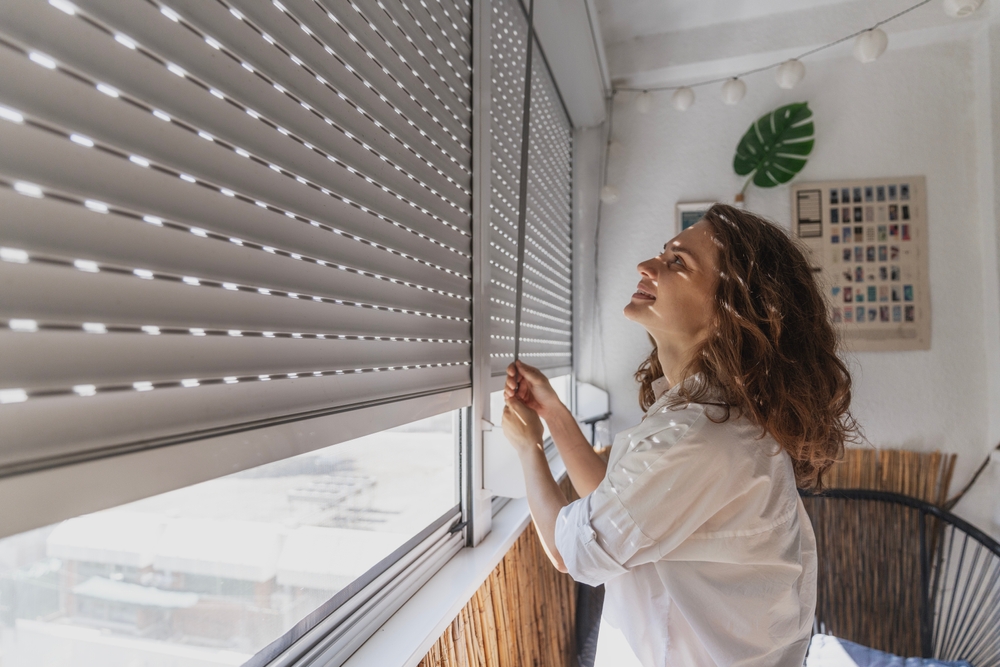With the colder months just around the corner, it’s time to think about weatherproofing your home before the chilly winds and rainy days hit Perth. Taking a few steps now will help keep things warm and snug as winter sets in.
From sealing gaps and upgrading your insulation to installing the best roller shutters, this guide will walk you through everything you need to weatherproof your home for whatever winter brings.
What is weatherproofing, and why does it matter in Perth?
Weatherproofing involves protecting your home from the elements, sealing it against wind, rain, drafts, moisture and temperature extremes. In a city like Perth, it’s much more important than you might think.
Winter here can bring heavy rains, gusty coastal winds and very chilly nights that sneak up fast. Without proper protection, your home can quickly lose heat, suffer water damage, and even rack up higher energy bills.
Good weatherproofing for winter helps your home stay warm, dry and energy-efficient. Whether it’s insulating the roof, sealing cracks around windows, or protecting your outdoor living spaces, it’s a smart move that makes the colder months a little more bearable.
Inspect and prepare: The pre-winter checklist
Before you go full speed ahead and start weatherproofing, it’s best to check out what you’re dealing with. This is about more than slapping on some seals and calling it a day.
It’s about giving your home proper care to see where the weak spots are. A little pre-winter prep now means you won’t be facing unexpected leaks or higher-than-usual heating bills later.
How to do a visual walk-around
First things first, start by stepping outside and looking over your home’s exterior. Focus on areas where air and moisture could creep in, such as cracks around the windows and doors, brittle caulking, loose cladding or damaged weather seals.
Don’t forget the roofline! Look for loose tiles, rusted flashing and signs of blocked gutters or downpipes. These areas can lead to costly internal water damage if left unchecked through heavy winter rains.
Key interior warning signs
Now take a lap indoors. Are certain rooms noticeably colder or draftier? Do your windows have condensation, or are the walls damp to the touch? These are signs that your insulation, seals, or airflow might not be up to scratch.
Also check high-moisture areas like bathrooms and laundries for musty smells or mould—these often indicate hidden leaks or poor ventilation. Catching these early helps you deal with minor issues before they spiral into costly repairs.
When it’s time to call in the pros
If you spot cracks in your foundation, sagging roof sections or persistent cold zones despite your best efforts, it might be time to get the professionals involved.
Experts can check for deeper structural issues, carry out thermal imaging to pinpoint heat loss, and professionally reseal areas that require more than just surface-level fixes. It’s an investment that can save you thousands in long-term repairs and energy costs.
Shielding your home from the winter elements
Your home’s exterior is its first defence against Perth’s winter mix of rain, wind and sudden cold snaps. To keep the inside warm and dry, you need to make sure the outside is sealed, insulated and equipped to cope.
From strong window barriers to protected outdoor zones, here are some of the best ways to keep your home weather-tight this winter.
Why roller shutters are perfect for Perth winters
If you’re serious about keeping the cold out and the warmth in, roller shutters are one of the best investments you can make.
They’re mounted directly over your windows, creating a snug, insulating barrier between your home and the outside world. In winter, this means less heat escaping and a noticeable drop in draughts, even on those windy, stormy Perth evenings.
Roller shutters also protect your glass from the impact of flying debris during storms, block out heavy rain, and even reduce outside noise. All of this helps make your home feel quieter and more secure. And with manual or motorised options, they’re easy to control no matter the weather.
How Ziptrak outdoor blinds make winters more comfortable
Outdoor living doesn’t have to go into hibernation just because the weather’s turned gloomy. Ziptrak blinds are built to seal off your alfresco area from wind, rain and even chilly breezes, turning it into a warm, usable space all year round.
They run along a sealed track system, so unlike traditional café-style blinds, there are no gaps for wind or water to sneak through. In Perth’s mild winters, this makes a huge difference! You can enjoy a warm cuppa on the patio or have friends over without everyone retreating indoors the moment the weather shifts.
Sealing the gaps for winter warmth
Once your shutters are down and your outdoor blinds zipped tight, it’s time to focus on sealing those persistent little gaps that quietly drain your home’s warmth. This is a key step in weatherproofing for winter.
Use weather seal tape, draught stoppers or flexible outdoor-grade caulking to target gaps around windows, doors, vents and external pipe entries. (Even keyholes and under-door spaces can be sneaky culprits.)
Unlike full repairs or installations, this part is simple enough to DIY. Sealing properly not only keeps warmth in, but keeps moisture out, helping prevent rot, rust and mould in the long run.
Insulating your home the right way
When it comes to staying warm in winter, insulation is your home’s unsung hero. Whether you’re upgrading or starting from scratch, understanding how to insulate effectively makes all the difference.
Types of insulation: What works best in Perth?
1. Bulk insulation (batts, rolls or loose fill)
This type traps air in its structure to slow down heat transfer. It’s ideal for ceilings and wall cavities. To install, fit batts snugly between joists or studs. Make sure there are no gaps, as even small spaces can let heat out.
2. Reflective insulation
This foil-based insulation works by bouncing radiant heat away from your home. It’s commonly installed in roof spaces to keep heat out during the day and warmth in at night.
To install it properly, make sure the shiny side is facing the direction of the heat source (typically the roof). It should be stretched out with an air gap between the foil and the roof material for it to work effectively.
3. Spray foam insulation
Spray foam insulation is applied as a liquid that expands rapidly to fill gaps, cracks and awkward cavities. It’s great for sealing around pipes, wiring or uneven surfaces where batt insulation wouldn’t fit properly. Once cured, it forms an airtight barrier that helps prevent drafts and heat loss.
You can install this type by spraying it directly into wall or roof cavities using specialised equipment. The foam expands quickly to seal every nook and cranny.
How to insulate key areas of your home
Now that you’ve got the types of insulation covered, it’s time to focus on the key areas of your home that need it the most.
1. Roof spaces
As heat rises, the roof is a major culprit when it comes to heat loss. Installing insulation in your ceiling or attic is one of the most effective ways to trap warmth in your home.
This is especially true in Perth, where the combination of hot summers and cool winters makes roof insulation critical for year-round comfort.
2. Wall insulation
Older Perth homes can lack proper wall insulation. If you’re renovating or retrofitting, this is an area to pay extra attention to.
Insulating your walls helps keep warmth inside. If you have brick walls, consider using cavity wall insulation or retrofitting with foam board or spray foam insulation to seal any gaps.
3. Floors over crawl spaces
Floors above crawl spaces are another area where heat escapes. If you don’t have underfloor insulation, you might notice cold drafts sneaking in.
Installing insulation beneath your floorboards can help seal the gaps and keep the chill at bay. As a quick fix, you can also use thick rugs to help trap heat and provide additional comfort.
4. Interior walls
Don’t forget about the walls that separate rooms in your home. Interior insulation helps maintain stable temperatures, especially in homes where certain zones are heated more than others. Insulating between rooms also improves comfort, particularly in open-plan homes, and can make a noticeable difference in reducing cold spots.
Insulation for sound and temperature control
Insulation isn’t just about keeping your home warm. It also gives excellent protection against outside noise. In Perth, where winter winds howl and rain taps against the windows, the right insulation helps block out those unwanted sounds.
- Noise reduction: Certain insulation materials, like acoustic batts or high-density insulation, are designed to absorb sound. This makes your home quieter, even during heavy storms.
Acoustic insulation is particularly useful in areas of the home where you want peace and quiet, like bedrooms or living areas.
- Multi-storey homes: If you have a multi-storey home, insulating between floors is a gamechanger. It reduces sound transfer, meaning that the noise from one level won’t disturb the rest of the house.
Make your home winter-ready with smart electrical and energy upgrades
Along with insulation and sealing, electrical upgrades are an essential part of getting your house ready for the colder months. Here’s what you need to consider:
Electrical safety checks before the cold sets in
When the winter chill rolls in, the last thing you want is an electrical issue disrupting your warmth and safety. For that reason, before the weather turns, get your circuits, switchboard and outdoor lighting inspected by experienced professionals.
Wet weather and faulty wiring don’t mix. Making sure everything is in top condition now can help avoid power outages, reduce fire risks and give you peace of mind throughout winter and beyond.
Warmth without wastage: Using automation
Efficiency is the name of the game when it comes to keeping your home warm without burning through your energy budget. Programmable thermostats and timer switches let you control when and how your heating runs. This is fantastic for keeping your home warm while avoiding unnecessary power consumption.
For even more convenience, consider integrating your roller shutters or Ziptrak blinds with smart systems. This way, you can automate the opening and closing of your blinds to manage light, temperature and privacy, all with minimal effort.
Lighting upgrades for cosy living
As the days get shorter and darker, your lighting plays a key role in keeping your home inviting. Swap out older light bulbs for energy-efficient LEDs, which provide a warmer, softer glow for winter evenings.
If you’re looking to save even more, install motion sensor lights outdoors. They not only boost security but also ensure your lights are only on when needed, saving energy and money during those wetter, gloomier months.
Get set for winter with MCF Master Group
Ready to weatherproof your property for Perth’s winter? Let MCF Master Group help you seal in warmth and comfort. Whether you need expert roller shutters to block out the chill, commercial roller shutters or electrical upgrades to guarantee safety and efficiency, we’ve got you covered!
Our team provides high-quality installations backed by reliable warranties, so you can enjoy peace of mind all season long. Get in touch with us today to start weatherproofing your property for the chilly months ahead.




